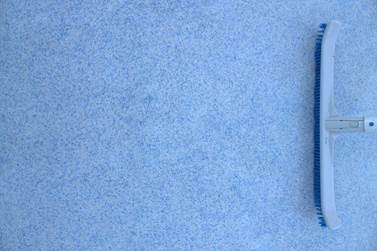Muriatic acid can dissolve and etch a plaster surface, even quartz aggregate pools. While genuine quartz aggregate is not affected at all by acid, the cement portion certainly is! (The cement portion is usually about 35% to 45% of the total plaster mix, which is exposed to the pool water.)
Therefore, why, after working hard to achieve a smooth, brand-new, hand-crafted, quartz pool-finish, would anyone immediately perform an “acid wash” on that pool? Yes, that would increase the exposure of the quartz color; but it also shortens the life of the plaster and causes future problems!
Although acid washing older plaster pools can be helpful to remove stains and scale, and restore the original appearance; that process, unfortunately, will make the surface more porous and prone to future streaking, blotchiness, and staining over time.
New plaster/quartz pools can be more easily damaged by acid than one that is even at least a month old. That is why a traditional start-up program helps prevent acidic and aggressive water from damaging a new finish.
Fortunately, there are better methods that will achieve exposure of the quartz color and retain a smooth and durable surface without damaging the pool finish.
Step 1: During the finishing process, properly time the troweling process to remove the weak, watery cement “cream” (known as laitance) that develops on a cement/plaster surface. The cement cream that accumulates on the trowel while hard troweling should be discarded.
Leaving a thin layer of cream on the surface while troweling not only prevents the color of the quartz from showing, but creates a weakened surface that will break down, deteriorate, and likely become unsightly over time.
It is commonly believed that as plaster hardens and “cures,” it will always, naturally release a cement component known as calcium hydroxide, which then results in “plaster dust” forming throughout the pool. That is not necessarily true.
Calcium hydroxide can be prevented from leaving the plaster surface in the first place, and instead, can be chemically converted into calcium carbonate (a much harder material) within the plaster matrix. When this is achieved; the surface is harder and smoother, and no plaster dust develops to foul the surface.
Step 2: Preventing calcium hydroxide from leaving a plaster surface can be achieved by the following. Create a “thick” plaster mix, and do not add calcium chloride. Do not add water to the plaster surface and trowel it into the surface. Delay the filling of the pool for at least 6 to 8 hours after finishing. (If the weather is hot and dry; tent the pool!) Fill the pool with +0.5 LSI water. (The Bicarb Start-up recommended by onBalance will accomplish that).
Step 3: An automatic pool cleaner can then be used to continually polish the plaster surface over time to maximize the quartz or pebble color.
If the above recommendations are followed, there will be no need to perform a “No Drain acid bath” (Acid Start-up or Zero Alkalinity Process) after the pool has been filled in order to eliminate plaster dust problems and expose the quartz color.
If a plaster surface begins to show light color blotchiness or streaking within a few weeks or months after completion, the acid wash or acid bath treatment that was performed when the pool was new may be the cause of the discoloration problems.
The benefit of following the above recommendations is a pool finish that is smooth, dense, durable, and stain resistant. The color of the exposed quartz will be vivid, consistent, and long-lasting, and that is what will make a pool owner willing to pay a premium for a special quartz finish.
There is a better way.

